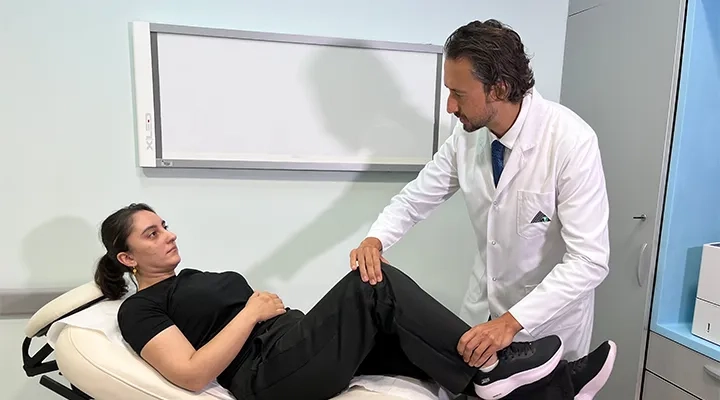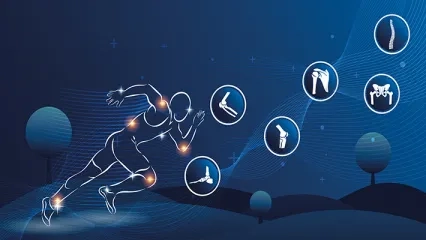Alo Yeditepe
Alo Yeditepe
Meniscus and Cartilage Transplantation Can Be Done at the Same Time
Young Patient Who Had Meniscus and Cartilage Transplantation at the Same Time: “I Can Now Do Sports and Run”
Simge Refika ALTIPARMAK, who lives in Rize, had to have surgery on her knee as a result of an accident at the age of 19, and a large part of her cartilage and meniscus were removed. Although everything went well for a few years after the surgery, She started to experience problems that affected her quality of life. The solution for ALTIPARMAK, who had difficulty in moving, was cartilage and meniscus transplantation performed at Yeditepe University Kozyatağı Hospital. Orthopedics and Traumatology Specialist Prof. Dr. Gökhan MERİÇ stated that the patient had serious damage to her meniscus at a very young age. Dr. Gökhan MERİÇ said, “For this reason, the wear on his knees started at an early age. We performed both meniscus and cartilage transplantation on our patient to prevent his complaints in the early period and to avoid the need for a prosthesis in the future and to continue his joint support. In this way, we both changed the joint surface and prevented any damage that may occur in the future.” he said.
Prof. Dr. Gökhan MERİÇ said that the patient waited for a donor for about 8 months after deciding on this surgery. Dr. MERİÇ said, “We completed a successful process after finding a suitable donor. "The fact that the patient continues her life in a healthy way today was worth the wait." he said.
“With Meniscus Transplantation, Cartilage Can Be Preserved, Especially in Young Patients”
Yeditepe University Kozyatağı Hospital Orthopedics and Traumatology Specialist Prof. Dr. Gökhan MERİÇ said that meniscus tear is a common disorder and treatment planning is determined according to the age of the patient. Dr. Gökhan MERİÇ continued his words as follows: “Sports injuries, in particular, are seen as caused by impacts and falls. It may also occur in elderly patients as a tear due to wear and tear of the meniscus structure. Meniscus is the protective tissue of the knee. It is a structure located between two bones and prevents the bones from rubbing against each other. When there is a tear in the meniscus, we make a plan according to the age of the patient. We usually follow minor tears with physical therapy and exercise. If there is a large tear, we definitely try to repair that meniscus, especially in young patients. Because we take precautions to prevent friction and wear, commonly known as calcification, in the future. For these reasons, we always try to repair the meniscus.”
"Unfortunately, in young patients where these repairs cannot be performed, in some cases such as large tears, the entire meniscus may need to be removed," said Prof. Dr. MERİÇ said, “In such cases, the process we call wear begins very quickly and in much younger patients. In order to prevent this wear, our goal is to take the removed meniscus tissue from another patient with a meniscus transplant and transplant it completely to damaged patients. "In this way, we protect the patient from cartilage damage and provide support tissue," he said.
'We do not Want to Have Prosthesis Before the Age of 60'
Stating that Simge Refika ALTIPARMAK suffered serious damage to her meniscus at a very young age, Prof. Dr. MERİÇ said, “For this reason, her meniscus was completely removed before and the wear on her knee started at an early age. We performed both meniscus and cartilage transplantation on our patient so that he would not need a prosthesis in the future and to support her knee joint. In this way, we changed the joint surface and prevented any possible damage in the future. We performed this surgery a year ago. Our patient can now use her knee very comfortably in her daily life.” he said.
Professor. Dr. Gökhan MERİÇ said that in patients whose meniscus was completely removed, as in this case, wear occurs over time, which creates the need for a prosthesis at an early age. Dr. MERİÇ said, “The wear and tear process may also create the need for prosthetic surgery. However, we do not want to make the prosthesis for our patients before the age of 60. After the patients' meniscus is removed, knee pain begins at the age of 25-30. At the age of 45, wear and tear can reach advanced levels. "Our aim with meniscus transplantation is to protect patients from wear and tear against the need for prosthetics that may occur in the future," he said.
'Organ Donation is also Important in Cartilage and Meniscus Transplantation'
Stating that they attach importance to biological treatment, Prof. Dr. MERİÇ said, “Metal implants can be made in any way, but it is important for us to protect and treat the patient's tissue. Cartilage transplantation is an operation we perform frequently and the success rate of the treatment is quite high. Meniscus transplantation is less common, but doing both is even more rare. Because both the meniscus and the cartilage must be worn. In addition, the patient must be young and have a suitable meniscus. After meniscus and cartilage transplantation, patients do not need to use medications like after organ transplantation. It does not require blood type and tissue compatibility. In surgery, we use tissues we receive from donors. Organ donation is also important in cartilage and meniscus transplantation. Because we have patients who need these tissues. "Organ donation has slowly started to increase in our society," he said.

“A Small Accident Caused a Big Problem”
Simge Refika ALTIPARMAK expressed her thoughts about the surgery as follows: “My process started at the age of 19. While walking, my knee turned and a meniscus tear and cartilage rupture occurred in my knee. My knee was locked and I urgently consulted a doctor. With the surgery, they removed a large part of the meniscus and cartilage in my knee because it was not repairable. Then my process started. I continued my daily life without any problems for the first 3-4 years. After the 5th and 6th years, my knee started swelling . So I started looking for a solution. The first thing I discovered while researching was that meniscus transplantation can be performed. That's how I applied to my doctor Prof. Dr. Gökhan MERİÇ. When I first came to Dr. MERİÇ, I learned the process. But my surgery did not happen immediately. I had a waiting period of about 8 months. Suitable tissue and cartilage could not be found. Then one day I received a phone call and was told that a suitable tissue had been found. “I quickly came to Istanbul and was taken into surgery.”
'I Can Now do Sports and Run'
ALTIPARMAK explained that before the surgery, She experienced swelling and severe pain in her knees and a sound coming from her knees when climbing stairs and standing for a long time, and explained her post-operative process as follows: “I had the surgery quickly after finding a suitable donor. My pain lasted for 3-4 days, but then it decreased and I recovered quickly and started receiving physical therapy. I received physical therapy two days a week for about 2-3 months. It is also necessary to strengthen the knee after the physical therapy process. I started Pilates and I still continue. After the correct treatments, my knee started to return to normal. I don't feel any pain right now. The biggest plus of the surgery for me was being able to climb stairs. There are no more noises when climbing stairs. Now I can do sports and run. There is nothing left that I missed. I am very happy in this respect. “I feel lucky.”
This content was prepared by Yeditepe University Hospitals Medical Editorial Board.
”
See Also
- Robotic Hip Replacement Surgery
- Knuckle Cracking Can Be Dangerous When It Becomes a Habit!
- What is Hallux Rigidus (Stiff Big Toe/Toe Arthritis)? Symptoms and Treatment
- What is Hallux Valgus (Bunion)? How is it Treated?
- Ergonomics in Automobiles Prevents Accidents
- Joint Pain and Causes of Joint Pain
- Walking and Returning to Social Life After Knee Replacement Surgery
- Robotic Knee Prosthesis Surgery
- Patients Who Undergo Joint Replacement Surgery Can Stand Up and Walk the Next Day
- Big Toes Can Be A Big Problem!
- What is Synovitis in Joints?
- Hip Impingement Syndrome
- What is the Future of Treating Cartilage Problems?
- Not Only Athletes Suffer from Meniscus Tears!
- Is Cartilage Damage More Common in Those Who Run for Long Periods?
- Beware If Your Shoulder Or Neck Pain Lasts Longer Than Two Days After Swimming!
- Mistakes While Swimming Can Cause Shoulder Pain
- Myths About Fractures
- Vitamin D Deficiency May Be The Cause Of Your Joint Pain
- Have Your Baby Take Their First Steps in Good Health
- Heavy School Bags Can Cause Pain in the Lower Back, Shoulders, and Hands!
- Sports Injuries
- Cartilage Transplantation from Donor Has Been Started to Perform in Turkey
- Working From Home Increases Waist and Neck Problems
- First Cartilage Transplant from a Donor
- Pay Attention to the Pain That Occurs in the Front Part of Your Knees While Playing Sports!
- Young Patient Who Could Not Walk Due to Cartilage Damage Recovered With Cartilage Transplantation
- Knee Arthritis
- Knee Pain
- Crunching in the Kneecap May Be a Sign of Calcification
- Injured Athletes Can Return To Sports With Cartilage Transplant
Alo Yeditepe


